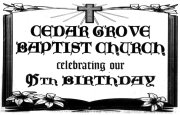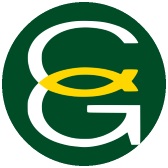Cedar Grove Baptist Church shares a rich 95-year home-town history
These are the original minutes written and recorded by the first church clerk:
Always referred to in the minutes as the Baptist Church of Christ at Old Six Mile Church, the body continued to meet monthly in the same building with the Six Mile Church until 1911, when the Baptist Missionary Association Conference requested that the Old Six Mile Church change its name and have a property settlement with the Six Mile Church.
In October 1911, interest in the property was sold for $75 to the Six Mile Church, and a committee was instructed to secure means to build a new church. J.M. Born sold the church one and one-half acres of land for $35 per acre, and the name was changed to Cedar Grove Baptist Church of Christ.
For the next few months the meetings were held at the Bethlehem Methodist Church, and then these words are written in minutes by Bertha Spears who was the church clerk:
"We had our first meeting in our new church April 14, 1912, the church made a motion to express to Bro. L.D. Spears thanks and appreciation for special good and nice work done in building our house, which carried by a unanimous rising vote. Bro. Spears made a proposition to the church to buy the paint and hard oil to complete the house and what he lacked collecting to pay for the same would wait until fall for the rest."
As was brought out in the minutes of the organizational meeting, Bro. W.A. Reagan, who pastored Central Baptist Church, was called to pastor the young church, which he agreed to do. He served until October 1909. E.H. Cunningham, called in March 1910, left in October 1910.
J.L. Fields served January 1911 until October 1912, and during this time the Sunday school was organized, which met each Sunday morning, with prayer meetings often held at night.
L.M. Sauls began his pastorate in 1913, was still shown as pastor in 1914, and was followed in the pulpit by L.A. Willingham.
G.C. Ivans was listed as pastor in 1918, F.M. Ferguson in 1921-1922, and C.L. Vermillion in 1928.
H.O. Malone was pastor of the church in 1929-1933, and when he resigned he recommended the church call Bro. Carroll Chadwick, which was done in September, and he continued with the church in 1934.
O.L. Bryant was pastor in 1935-1936, V.G. Garrett in 1937, followed by C.H. Muxworthy in 1938.
M.L. Boland was pastor the next few years, and C.L. Smith came to the church in 1944-1946, during which time the church went to half-time work.
James E. Thompson, called in 1947, resigned in 1948, and about this time two Sunday school rooms were put into the back of the auditorium.
During the tenure of P.C. Pemberton, which lasted from August 1948 to November 1953, the church went to full-time work. A butane system was installed, and the Sunday school rooms were added to the building.
J.C. Howell was called as pastor in January 1954 and served until April 1957, followed by James A. Strickland, who stayed until September 1959. New church furniture was installed at this time.
Martin Spell served from December 1959 to September 1960; the church was painted and got a new roof.
Don Stiles was pastor from December 1960 to March 1962. He was followed by Wayne Sage, who was ordained by the church in 1962.
A.P. Bazer was pastor from May 1963 to November 1967.
The present pastor, Freddy Mason, has been at the church since January 1968. During this time the church auditorium has been repainted, air conditioners and new piano added, the windows replaced, floors carpeted, the porch and church sign added, the water and plumbing installed, cabinets built, Sunday school rooms repainted, and the outside wood covered by vinyl and metal trim.
The most recent changes to date are: a new fellowship hall, a new auditorium, new paved parking facilities, and new pews with matching pulpit furniture.
The membership at Cedar Grove has grown over the past 95 years and today numbers approximately 265.
Cedar Grove Baptist Church has been the starting point for many young pastors, and recognizes the importance of its role as counselor during this very crucial time of their careers.
Source: The Panola Watchman (Carthage, Tex.), Vol. 128, No. 9, Ed. 1 Sunday, January 28, 2001, newspaper, January 28, 2001; Carthage, Texas. (https://texashistory.unt.edu/ark:/67531/metapth1288681/m1/48/: accessed October 16, 2020), University of North Texas Libraries, The Portal to Texas History, https://texashistory.unt.edu; crediting Sammy Brown Library.



